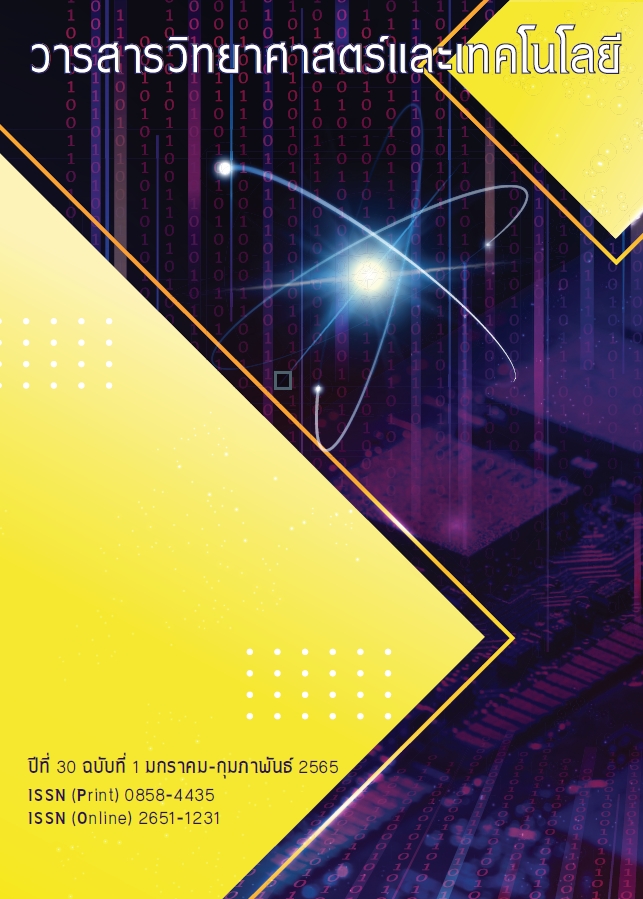Bayesian Estimation using Metropolis-Hastings Algorithm of Gumbel Type-II Distribution
Main Article Content
Abstract
This research aims to compare the performance of the parameter estimation by the Bayesian approach of the Gumbel type-II distribution on four methods, namely independent metropolis-hastings algorithm, random walk metropolis algorithm, independent metropolis-hastings algorithm with Gibbs sampling, and random walk metropolis algorithm with Gibbs sampling. The comparison among methods is made in terms of the mean square errors based on the Monte Caro simulation technique. The shape parameters were chosen to be 0.5, 1, 2, 3, and 4, the scale parameters were chosen to be 0.5, 1, and 2 and the sample sizes were chosen to be 20, 50, and 100. The prior distribution of both parameters was assumed to be the Gamma distribution. Moreover, we apply four methods for real data. The findings show that the random walk metropolis algorithm and the independent metropolis-hastings algorithm with Gibbs sampling present the best performance in most cases under a simulation study. For real data, the independent metropolis hastings algorithm with Gibbs sampling offers the best performance.
Article Details
References
Gumbel, E. J., 1958, Statistics of Extremes,Columbia University Press, New York, 375 p.
Feroze, N. and Aslam, M., 2012, Bayesian Analysis of Gumbel type-II Distribution under Doubly Censored Samples Using Different Loss Functions, Caspian Journal of Applied Sciences Research. 1(10): 1-10.
Abbas, K., Fu, J. and Tang, Y., 2013, Bayesian Estimation of Gumbel type-II distribution, Data Science Journal. 12: 33-46.
Okorie, I.E., Akpanta, A.C. and Ohakwe, J., The Exponentiated Gumbel Type-2 Distribution: Properties and Application, International Journal of Mathematics and Mathematical Sciences, Available Source: http://dx.doi.org/10.1155/2016/5898356, August 4, 2016.
Lindley, D.V., 1961, The Use of Prior Probability Distribution in Statistical Inference and Decision, Proceedings of the Fourth Berkeley Symposium on Mathematical Statistics and Probability, pp. 453-468.
Gilks, W.R., Richardson, S. and Spiegelhalter, D., 1996, Markov Chain Monte Carlo in Practice, Interdisciplinary Statistics, Chapman and Hall, London, 512 p.
Geman, S and Geman, D., 1984, Stochastic Relaxation, Gibbs Distributions and Bayesian Restoration of Images, IEEE Transaction Pattern Analysis and Machine Intelligence. 6: 721-741.
Hastings, W.K., 1970, Monte Carlo Sampling Methods Using Markov Chains and Their Applications, Biometrika. 57(1):97-109.
Moala, A.F., Romos, L.P. and Achcar, A.J., 2013, Baysian Inference for Two-Parameter Gamma Distribution Assuming Different Noninformative Priors, Revista Colombiana de Estadistica. 36(2), 321- 338.
Ahmed M.O., 2014, Comparison of the Bayesian Methods on Interval-Censored Data for Weibull Distribution, Open Journal of Statistics. 4: 570-577.
Saraiva, E.F. and Suzuki, A.K., 2017, Baysian Computational Methods for Estimation of Two-Parameters Weibull Distribution in Presence of Right-Censored Data, Chilean Journal of Statistics. 8(2): 25-43.
Saraiva, E.F., Suzuki, A.K., and Milan, L.A., Bayesian Computational Methods for Sampling from the Posterior Distribution
of a Bivariate Survival Model, Based on AMH Copula in the Presence of Right-Censored Data, Entropy, Available Source: https://doi.org/10.3390/e20090642, August 27, 2018.
Haselimashhadi, H., Vinciotti, V. and K. Yu, K., 2018, A novel Bayesian regression model for counts with an application to
health data, Journal of Applied Statistics. 6: 1085-1105.
Kundu, D. and Gupta, D.R., 2008, Generalized Exponential Distribution: Bayesian estimations, Journal of Computational Statistics & Data Analysis. 52(4): 1873- 1883.

